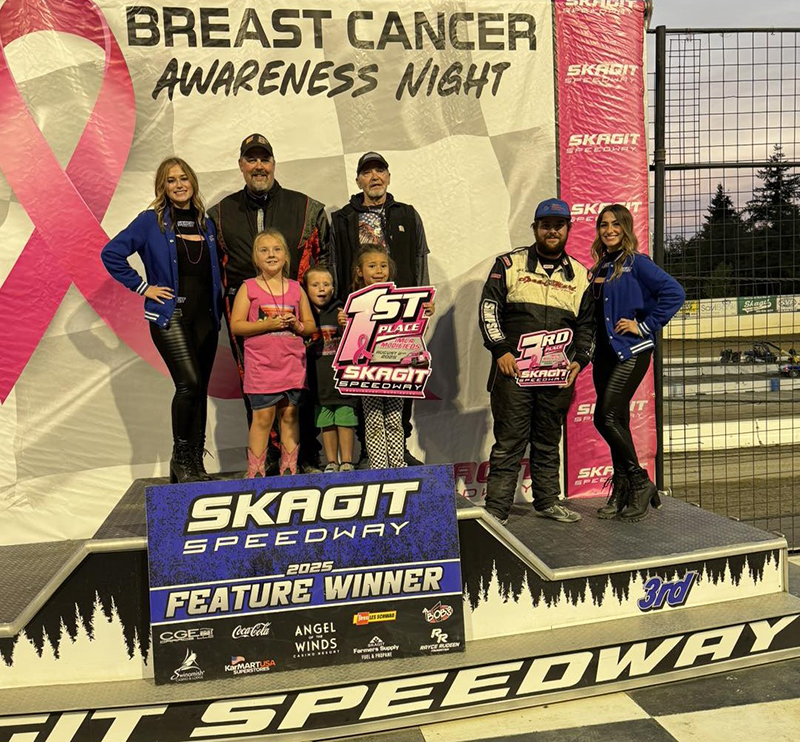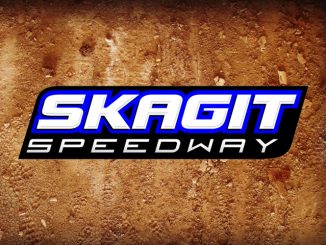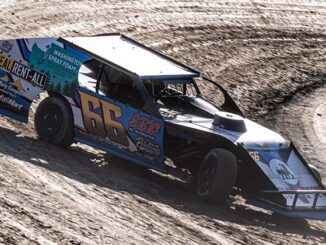
By Ben Deatherage
MOUNT VERNON, Wash. (Sept. 19, 2025) — The Skagit Valley stretches north of Seattle, where the Skagit River bends through farmland and tulip fields before emptying into Puget Sound. Along its banks sits Mount Vernon, a city first carved out by loggers in the 1870s and toughened by floods, fires, and the grit of rebuilding.
Just beyond town, the mist of the North Cascades rolls down into fields of color each spring, while at night the roar of Skagit Speedway turns the valley into a dirt-slinging cathedral. For Rick Smith, it’s more than a backdrop — it’s home, and the stage where three generations of his family have chased speed.
That stage nearly slipped away in December 2024, when Smith suffered a heart attack and underwent open-heart surgery. But eight months later — on Aug. 2, his 35th year in the sport — he was back in victory lane at Skagit Speedway in his Friesen Performance IMCA Modified.

Rick Smith celebrates in victory lane at Skagit Speedway on Aug. 2, marking his 35th year of racing with a Friesen Performance IMCA Modified feature win. (Track Photo)
Three Generations at Skagit
Smith’s connection to racing runs deep. His father Dick was a local Stock Car driver who started in 1972, and his older brothers followed suit in Late Models and Modifieds. His brother Kevin later turned laps in Sprint Cars, before returning to the IMCA Modifieds.
“My older brother Terry, who passed away a couple of years ago, talked me into getting into a race car at 17 years old,” Rick recalled. “My first few laps I crashed the car, broke a spindle, and said I never want to race a car again.”
But racing had already taken hold. After a stint in the military, Smith met a fellow serviceman who was a racer himself. The conversations lit a spark — maybe, just maybe, he could get behind the wheel again. When he returned home, Smith went straight to his father with the idea. His dad didn’t hand him the keys right away.
“He told me I needed to spend time working on the cars first,” Smith said. “So I wrenched on them for a year, watched him race, pitted for him. Eventually, he let me mudpack, then hot lap, and finally run a couple of heats.”
By 1991, those lessons turned into a full rookie season. From there, the history wrote itself: Late Models, Sprint Cars, and now IMCA Modifieds — with wins and championships along the way.
Resilience Off the Track
The December 2024 heart attack was Smith’s toughest opponent yet. Three months later, he underwent open-heart surgery, a test of resilience that mirrored the grit of Mount Vernon itself.
“I was sitting in my doctor’s office in June, and he said I was 100 percent,” Smith recalled. “I asked if I could drive my race car. He said I’m safer in the race car than on the highway. So I said, I guess we’re going racing.”
Three months later, Smith swapped seats with his nephew Austin, climbed back into his Modified, and returned to Skagit — winning his first night back.
“I’ve helped a lot of drivers over the years, and one of them is Cole Logan,” Smith said. “He’s been around me since he was 14. Now he’s winning races in a car I sold him. At Skagit, he passed me for the lead — and I thought, ‘Guess I better drive harder.’ Two laps later, I passed him back and won. That was pretty cool.”
A Home in the Valley
Mount Vernon’s story reaches back to the 1870s, when settlers Jasper Gates and Joseph F. Dwelley saw opportunity in the region’s vast timber. Their vision nearly failed — a massive log jam on the Skagit River choked off growth until it was finally cleared in 1876. With the river open and railroads arriving, the community flourished. By 1893, Mount Vernon was incorporated.
Floods and setbacks followed, but grit and persistence became hallmarks of the town’s character. Today, it balances its deep history with natural beauty — tulip fields, the Skagit County Fair, and quick access to both saltwater bays and mountain passes. It’s a place where resilience runs as deep as the river that first defined it.
“Mount Vernon is a small town, and I’ve grown up here my whole life,” Smith said. “We have the fair in August, Tulip Town in the spring, Deception Pass close by, and you can make the short drive to the North Cascades. There’s a lot to do with all the parks, trees, and mountains.”
It’s also centrally located — an hour from Seattle, a short hop to Vancouver, B.C. — but for Smith, the heart of home is still Skagit Speedway, the dirt oval that’s been part of his life since childhood.

A roadside sign greets visitors to Mount Vernon, Washington, a city rooted in logging and farming and now famous for its tulip fields and Skagit Valley heritage. (Photo by InspiredPencil)
The Racing Today
When Skagit Speedway returned to IMCA sanctioning in 2022 for the first time since 1997, Smith welcomed the change — and wasted no time proving himself.
“We were sitting up here on our own, and it was great that IMCA came in,” he said. “It gives us a chance to run for a state championship and to travel to Grays Harbor Raceway in Elma. They’ve been good about not racing against each other, so we can go back and forth.”
That first season, Smith won six features, finished runner-up in the rest, and clinched the track championship. He also made a strong run in the inaugural “Survive the 55,” the track’s marquee Modified event.
Competition has only grown. “We’ve had new guys come in, getting better cars, winning races,” Smith said. “Some of them came from Midgets or Sprint Cars, and they’ve adapted quickly. It’s become harder to win a weekly show.”
For Rick Smith, racing is no different than Mount Vernon itself — shaped by history, tested by setbacks, and always finding a way to rise again beneath the lights of Skagit Speedway.



